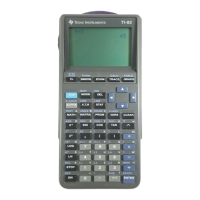18 Calculator Keystroke Guide
Y1. Enter as Y2 the expression
. Enter as Y3 the expression 18
2
−
x
. Press GRAPH to
see all three graphs displayed. Press the TRACE key to activate the Trace cursor. The Trace cursor
will appear on the graph of Y1, as it did before. To make the Trace cursor move to the other
straight-line graph, the graph of Y2, press the Down Arrow key. Move the Left and Right Arrow
keys to trace along the graph of Y2. To make the Trace cursor move to the curved graph of Y3,
press the Down Arrow key again. Move the Left and Right Arrow keys to trace along the graph of
Y3. If you press the Down Arrow key once more, the Trace cursor will cycle back to the graph of
Y1. (If four graphs were displayed, the Trace cursor would have moved to the graph of the fourth
equation.) Pressing the Up Arrow key makes the Trace cursor move from graph to graph in
reverse order. While the Trace cursor is on, try pressing the Up Arrow key a few times to see how
the Trace cursor moves from graph to graph.
page 103
24 Test
The items on the TEST menu may be used to tell whether a relationship between two numbers or
expressions is true or false. To see how it works, let's let the calculator verify something you
already know: 7 is less than 8. At the Home screen type a 7 and then press 2nd [TEST] (the second
function on the MATH key) to produce the TEST menu. The "less than" symbol < is choice 5 on the
menu. Either press 5 or use the Down Arrow key to highlight the 5 and press ENTER. The <
symbol will appear on the Home screen after the 7. Then type an 8, so that the Home screen now
shows 7<8. You want to know if this statement is true. The calculator will tell you when you
press ENTER. The calculator will display a 1 if the statement is true or a 0 if the statement is false.
In this case, of course, the calculator displays a 1, since 7 is less than 8.
Now let's enter a false statement: 4 > 11. Type a 4 and then press 2nd [TEST] to produce the
TEST menu. The "greater than" symbol > is choice 3 on the menu, so press 3 to produce the >
symbol on the Home screen after the 4. Now type 11 and press ENTER. The calculator displays a
0 to tell you that the statement is false.
Next let's try one that perhaps isn't so obvious. Is
93
59
8
5
> ? Type in 5/8 > 59/93 (using the
division key ÷ to produce the diagonal slash division sign /) and press ENTER to find out. The
statement is false, since the calculator responds with a 0.
The TEST menu may also be used to test proposed solutions of equations. For example, to test
whether 2 is a solution of the equation
531
x
, first store 2 as the value of x. (See 14 Store.)
Then type in the equation
531
x
and press ENTER. (Note that “=” is choice 1 on the TEST
menu.) Since the calculator displays the value 1 (true), 2 is a solution of the equation. Using the
same method, test whether –2 is a solution of the equation
xx
152
. After you store –2 as
the value of x and then type in the equation, the calculator should display the value 0 (false) when
you press ENTER, indicating that –2 is not a solution of the equation. Note: This approach to
testing solutions of equations is reliable only for exact solutions. Rounded solutions or other
approximate solutions usually do not test as correct.

